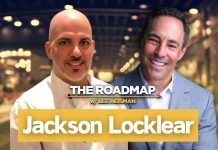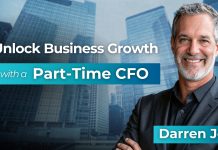Many companies transitioned to a work-from-home model as the coronavirus progressed across the country. Today, more than a year later, some have returned to the office but a large number are still working from home or trying to determine if a hybrid model would be best. On today’s show, we’re pleased to welcome small business expert, serial entrepreneur, and CEO of CFOshare, LJ Suzuki, to discuss a recent study on the business costs of working from home versus working from the office or a hybrid model of the two.
Transcription:
Jim Fitzpatrick:
Welcome back and thank you so much for joining us once again, LJ.
LJ Suzuki:
Thanks for having me, Jim. Always a pleasure.
Jim Fitzpatrick:
Sure. I’m going to let you take it from here. Lots of businesses are trying to decide they should return to the office or continue to work from home or a hybrid as I mentioned in the opening there. How did your team analyze this question?
LJ Suzuki:
Yeah, it’s a great question. As a business owner myself, I was wondering, what should we do next? Should we continue working from home? Should we come back to the office? Should we do a hybrid my model? I’ve been listening to a lot of podcasts and reading a lot of stories from experts talking about the pros and cons of each. But not a lot of people were looking at the data of it. There were some studies that were done maybe five or six years ago, but that was before we had technologies like Zoom that were really robust, technologies like Slack that helped us collaborate. And so I wanted to take a look at our company’s actual information, our data to understand what were the costs, what were the benefits and financially speaking, what is the most advantageous model?
Jim Fitzpatrick:
Yeah, for sure. What did your analysis find out or discover?
LJ Suzuki:
Yeah, so we looked at a number of different elements to it. One of it was explicit costs. For example, the rent I pay in the office or a work from home stipend that I pay to my employees. Another element was productivity. A third element was quality. So the quality of the work that presumably would be better or worse either from home or from office. And then the last element was employee satisfaction. And although there’s a lot of downsides to work from home, especially employees that maybe get lonely or that don’t necessarily have that fun social interaction, we found that the productivity and the reduction in office expenses more than offsets that cost by a pretty significant factor. And so in the data that we looked at for our services business, work from home was by far the most financially compelling, followed number two by the hybrid model, which was halfway between the benefits between office and full work from home exactly.
Jim Fitzpatrick:
And you’re talking about the cost for the employer or the business, not for the–
LJ Suzuki:
This is explicitly from the business’ perspective. Now, there’s some employee benefits as well to work from home. The biggest one or the biggest two, I should say is number one, you don’t have to commute. Universally our employees stated that they do not like driving to work, even if they do like being at work. And the number two benefit is that you can work from anywhere if you’re working from home. Our business is located in Denver, Colorado, but a lot of our employees took the opportunity to go to the mountains, to a small mountain town to take vacations with their family. We even had one employee that worked from Hawaii for a couple months, and that was an incredible source of employee satisfaction to have that liberty.
Jim Fitzpatrick:
Yeah. It also opens up the path to getting anybody to work for your company from anywhere around the country, around the world for that matter, but specifically around the country. If I’m in New York city and it cost a fortune to live in New York city, therefore I’ve got to pay a six figure income to an entry level individual, that person might live outside of Atlanta someplace that’s very inexpensive and say, “I’ll work for your company for half of that.” Right?
LJ Suzuki:
That’s exactly right. And we see that dynamic in the finance industry itself where New York tends to be a big financial hub where it’s very expensive. Denver is also a relatively sized financial hub. Accountants and financial planners here are expensive. But a place like Des Moines, Iowa has a lot of financial talent and a much lower cost of living, and so the salaries there are quite a bit lower. What we tend to do is just pay the same salary no matter where you live. And if you decide that you want to live in the Appalachian mountains in your little reclusive shack and just have a ton of disposable income, that works fine for us and for you.
Jim Fitzpatrick:
That’s right. What do you do with the employees though that say well it seems to not be fair because you’re asking us to come in. Are we all supposed to come in? Is that mandatory? Or is it optional? And then you’re allowing it for some employees to not work in the office and work remotely, but not others. Does it create animosity? I would imagine it would. Right? When somebody says, “Well, I’ve got to come in, but then you just hired somebody that’s not here. You’re almost rewarding the new person before you’re taking care of your old timers.” Right?
LJ Suzuki:
That’s a really good question. And one of the biggest financial components that we saw, one of the biggest weighing things is productivity. In general, our employees were much more productive in the work from home model than they were in the work from office model. And that’s just measured in terms of pure output. Right? And we found that they were about half as productive in what we call the hybrid model. Our hybrid model was one day a week required to be on site in the office. And then four days a week are optional. You could go in or you could stay home. It’s your choice.
LJ Suzuki:
However, what we discovered is that our workforce tended to split down the middle with my accountants preferring to work from home, and my financial analysts and planners preferring to work in the office. The reason why is financial planning is a collaborative process. It requires a lot more team meetings. It requires a lot more working with other people to brainstorm and come up with ideas. It’s very creative. Whereas accounting is the kind of task where you could delegate certain sections of it and work within your silo and just check in once or twice a day. The accountants found that it was much easier to do that from home than it was from the office.
Jim Fitzpatrick:
Right. There’s a company that we interviewed not too long ago. Actually, this was prior to COVID. So I guess it was about a year and a half ago, right before COVID hit. We interviewed them. The name of the company is Buffer, and Buffer always had a remote work environment. They never had a corporate headquarters. They still don’t to this day for obvious reasons. But they said it worked completely. It was great for them because they could get talent from anywhere around the country. Their employees were happier because they could work from home, set up their home offices and such. And of course, lo and behold, when COVID hit, they were like, “We didn’t know any other way. This was the only structure. This was the only arrangement that we had with our associates.”
Jim Fitzpatrick:
And it worked well for them. They did say it may have taken a little bit of a toll on culture because you just couldn’t get the team together. Once a year, they brought the entire team together on a retreat type event and spent four or five days everybody together. And that seemed to do the trick. But so there are companies out there that I think through this have said, in fact, I know of a couple that have said, “You know what? We don’t need the office. We’re shutting it down. We’ve worked remotely for a year successfully. We don’t need the office.” Especially for those companies that are up against now where their lease is coming due. And you’re looking around 10,000 square feet, 20,000, 30,000 square feet for these small business owners that are saying, “Are we going to really go into another five year lease when the people aren’t even coming in?”
Jim Fitzpatrick:
And then there’s companies out there that seem to be bringing their people in just because they have 10,000 square feet. And they say, “Darn it, we’re paying for this. We want to see people coming in here.” At the end of the day, it begins to build a resentment on the employees, because they’re like, “Are you bringing us in just because you’re renting this space because we still could have done this work at home.” Right?
LJ Suzuki:
Yeah, exactly. And so when we modeled the explicit cost of work from home, we took out office rent, but we included a one day per month all staff meeting, and it seems that you would be renting a hotel conference room, having it fully catered, something like that. Even with those costs baked in, the explicit costs of work from home are still less than the explicit costs of renting an office. Then when you pile in the productivity improvements on top of that, it’s a no-brainer between the two.
Jim Fitzpatrick:
Sure. No question about it. And I think that from all of this, companies are realizing that they can do more on a lot less and it really is a very interesting finding, because we’re all thinking, oh my gosh, this is going to kill our businesses. And when are we all going to get back together again? And when are we going to be a big happy company? And lo and behold, in a lot of businesses, we might not see that time. The new company model could very well be working remotely. Right?
LJ Suzuki:
It very well could be. Now, there is one thing in that I do want to point out in our study though, that was an interesting and unexpected anomaly. I told you about our two departments, the accounting team and the finance team. And the accounting team tends to work more individually. The finance team tends to work more collaboratively. Well, we found that both teams became more productive in the work from home model, but the finance team became even more productive in a hybrid model, so they went from 5% efficiency gains in work from home to 10% efficiency gains in the post-pandemic hybrid model where you could optionally go into the office.
LJ Suzuki:
On the other hand, my accounting team lost all of their productivity gains when we were went back to hybrid. It was almost as though they were back in the office in terms of their productivity, even though they had the option to do either one. What this tells me is the productivity gains, which again are the most important financial elements of work from home versus work from office in our analysis, those productivity are highly sensitive to the nature of your work. Whether you are individual contributor, get your checklist and your inbox done every month, which is very productive work from home. Or if you’re more of a collaborative meet with people, be creative, have to bounce ideas off the wall group, which is much more productive as it turns out in a hybrid model than even having to go into the office.
Jim Fitzpatrick:
Yeah. Very interesting. Isn’t it? And then so many small business owners right now are listening to us have this discussion. And in some respect, they’re even more confused now because now they’ve got to take a look at their own business and say, okay, now how do we run our own study to find out who’s going to be more productive at home and who’s going to be more productive in office, and maybe they don’t all have the resources that you’ve got or other companies have to determine that. This is a question that I think we’re going to be asking ourselves for some time, isn’t it? What’s right for my specific business? And of course the hospitality and restaurant industry and retail and things like that, they don’t really have a choice. You got to be there. The customer, if there’s an open sign and there’s a door, the company’s got to have people in there. Right?
LJ Suzuki:
Absolutely. I think you need to look at your own business. And your solution, it might be like ours where you have two or three different solutions. You might have employees that need to be on site in order to serve your customers. There’s no question about it. Then you might have employees that need to collaborate, that are creative or that work best in teams that a hybrid solution is going to be best for them. And then you might have employees that are individual contributors that work from is going to be best for them. And the financially most compelling model is one that accommodates all three of those different work styles.
Jim Fitzpatrick:
Sure. Let me ask you this. Out of 100 workers, the average worker out there that that went from office setting to working remotely through the pandemic. What’s the percentage of those would you say, and I don’t know if you know the answer to this or not. How many want to come back into the office, and how many want to stay home?
LJ Suzuki:
Yeah. I do not know any statistics about that, but I can tell you from my team’s perspective, it was almost one-third, one-third, one-third. And the third category is people that want to go into the office, but only if other people are going to be there. [crosstalk 00:12:53] They might go into the office on a Monday morning, and they’re the only ones that showed up because it’s Monday. Right? And they were disappointed. And so then they stopped coming in until they know that other people will be there to hang out with.
Jim Fitzpatrick:
That’s right. That’s an interesting finding, isn’t it? I want to go in, but I want to be able to have it be somewhat of a social scenario as well.
LJ Suzuki:
Exactly.
Jim Fitzpatrick:
Find out exactly how the team’s doing and how everyone’s hanging in and who’s doing what and the whole deal.
LJ Suzuki:
Exactly.
Jim Fitzpatrick:
It’s very interesting. Well, LJ Suzuki, CEO of CFO Share and a small business expert and serial entrepreneur and all around great guy. We really appreciate all your contribution to our network. Thank you so much for joining us once again. I know that our viewers and subscribers will get a lot out of your visit with us here today, so thank you.
LJ Suzuki:
Great. Thank you, Jim.
The Atlanta Small Business Network, from start-up to success, we are your go-to resource for small business news, expert advice, information, and event coverage.
While you’re here, don’t forget to subscribe to our email newsletter for all the latest business news know-how from Atlanta Small Business Network.







